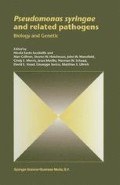Abstract
Many micro-organisms including pathogenic and saprophytic bacteria react with plant cells in the intercellular spaces inducing different defence responses. The local Early Induced Resistance (EIR) is a first line defence mechanism against bacteria. Here an overview will be given of this local, nonspecific, symptomless defence mechanism as a separate entity from the incompatible-specific Hypersensitive Response (HR). The EIR operates 1–6 h after inoculation (hpi) for about one day depending on temperature and leaf age. The EIR can be inhibited by a short heat shock (50°C for 15 sec) of leaves or by a plant protein synthesis inhibitor, cycloheximide (5 µg m1−1). In a compatible host-pathogen relationship (Pseudomonas syringae pv. tabaci/tobacco) the effect of EIR does not eventuate. However, the EIR develops simultaneously with the HR and sometimes is able to prevent it when the induction time of HR is longer than the time required for the development of the EIR (e.g. P. s. pv. phaseolicola does not induce HR in tobacco above 28°C). It seems that the EIR inhibits the metabolism of bacteria and the activity of hrp genes. Moreover, EIR activates the accumulation of H2O2 at the bacterial attachment site expressing new peroxidase isoenzymes in the initiated plant tissue. Further investigations, hopefully, will clarify the relationship of other complementary defence mechanisms like local late induced resistance (LIR) examined by Sequeira (1983) and Mazzucchi and co-workers (1979), Minardi (1995), Newman et al., (2001).
Access this chapter
Tax calculation will be finalised at checkout
Purchases are for personal use only
Preview
Unable to display preview. Download preview PDF.
References
Bozsó, Z., 2000, PhD Thesis Bacterial infection induced early defence reactions and their interactions. Szent. Istvân University, Gödölld, Hungary
Bozsó, Z., Ott, P.G., and Klement, Z., 1997, HR-positive phenotype of the Pseudomonas syringae pv. syringae hrpK mutant and hrp gene superinduction in tobacco leaves treated with protein synthesis inhibitors. In Pseudomonas syringae Pathovars and Related Pathogens ( K. Rudolph, T.J. Burr, J.W. Mansfield, D. Stead, A. Vivian and J. von Kietzell, eds.), Kluwer Academic Publishers, Dordrecht, The Netherlands, pp. 122–126.
Bozsó, Z., Ott, P.G., Kecskés, M.L., and Klement, Z., 1999, Effect of heat and cycloheximide treatment of tobacco on the ability of Pseudomonas syringae pv. syringae 61 hrp/hrmA mutants to cause HR. Physiol. Mol. Plant Pathol. 55: 215–223.
Bozsó, Z., Ott, P.G., Kecskés, M.L., Czelleng, A., and Klement, Z., 2001, Non-specific, peroxidase and H2O2 associated reactions of tobacco leaves after infiltration with hrp/hrmA mutants of P. syringae pv. syringae 61. Proceedings of the 10th International Conference on Plant Pathogenic Bacteria, Charlottetown, Prince Edward Island, Canada, July 23–27, 2000. In Plant Pathogenic Bacteria (H. De Boer S.H. ed.), Kluwer Academic Publishers, Dordrecht, The Netherlands, pp. 195–198.
Burgyân, J., and Klement, Z., 1979, Early induced selective inhibition of incompatible bacteria in tobacco plants. Phytopathol. Medit. 18: 153–161.
Dow, M., Newman, M.A., and von Roepenack, E., 2000, The induction and modulation of plant defence responses by bacterial lipopolysaccharides. Ann. Rev. Phytopathol. 38: 1–21.
Gomez-Gomez, L., and Boller, T., 2002, Flagellin perception: a paradigm for innate immunity. Trends Plant Sci. 7: 251–256.
Jackson, R.W., Athanassopoulos, E., Tsiamis, G., Mansfield, J.W., Sesma, A., Arnold, D.L., Gibbon, M.J., Murillo, J., Taylor, J.D., Vivian, A., 1999, Identification of a pathogenicity island, which contains genes for virulence and avirulence, on a large native plasmid in the bean pathogen Pseudomonas syringae pv. phaseolicola. Proc. Natl. Acad. Sci. 96: 10875–10880.
Klement, Z., 1982, Hypersensitivity. In Phytopathogenic Prokaryotes II (M.S. Mount and G.H. Lacy, eds.), Academic Press, New York, USA, pp. 149–177.
Klement, Z., Bozs6, Z., Kecskés, M.L., Besenyei, E., Czelleng, A., and Ott, P.G., 2003, Local early induced resistance of plants as the first line of defence against bacteria. Pest Manage. Sci. (in press).
Klement, Z., Bozsô, Z., Ott, P.G., Kecskés, M.L., and Rudolph, K., 1999, Symptomless resistant response instead of the hypersensitive reaction in tobacco after infiltration of heterologous pathovars of Pseudomonas syringae. J. Phytopathol. 12: 479–489.
Klement, Z., Farkas, G.1., and Lovrekovich, L., 1964, Hypersensitive reaction induced by phytopathogenic bacteria in the tobacco leaf. Phytopathology 54: 474–477.
Lovrekovich, L., and Farkas, G.L., 1965, Induced protection against wildfire disease in tobacco leaves treated with heat-killed bacteria. Nature 205: 823–824.
Mazzucchi, U., Pupillo, P., 1976, Prevention of confluent hypersensitive necrosis in tobacco leaves by a protein-lipopolysaccharide complex. Physiol. Plant Pathol. 9: 101–102.
Minardi, P., 1995, Altered expression of Erwinia amylovora hrp genes in tobacco leaves pretreated with bacterial protein-lipopolysaccharide complexes. J. Phytopathol. 143: 199–205.
Ott, P.G., 2002, PhD Thesis Characterisation of plant processes of the early induced resistance (EIR) and the hypersensitive reaction (HR) and their interactions. Szent Istvân University, Gödölld, Hungary.
Sequeira, L., and Hill, L.M., 1974, Induced resistance in tobacco leaves: The growth of Pseudomonas solanacearum in protected tissues. Physiol. Plant Pathol. 4: 447–455.
Sequeira, Z., 1983, Mechanism of induced resistance in plants, fungi, viruses, bacteria. Ann. Rev. Microbiol. 37: 51–79.
White, F.F., Yang, B., Johnson, L.B., 2000, Prospects for understanding avirulence gene function. Curr. Opin. Plant. Biol. 3: 291–298.
Author information
Authors and Affiliations
Editor information
Editors and Affiliations
Rights and permissions
Copyright information
© 2003 Springer Science+Business Media Dordrecht
About this paper
Cite this paper
Klement, Z., Bozsó, Z., Besenyei, E., Czelleng, A., Kecskés, M.L., Ott, P.G. (2003). Early Induced Resistance, a General, Symptomless Plant Response to Bacteria. In: Iacobellis, N.S., et al. Pseudomonas syringae and related pathogens. Springer, Dordrecht. https://doi.org/10.1007/978-94-017-0133-4_32
Download citation
DOI: https://doi.org/10.1007/978-94-017-0133-4_32
Publisher Name: Springer, Dordrecht
Print ISBN: 978-90-481-6267-3
Online ISBN: 978-94-017-0133-4
eBook Packages: Springer Book Archive

